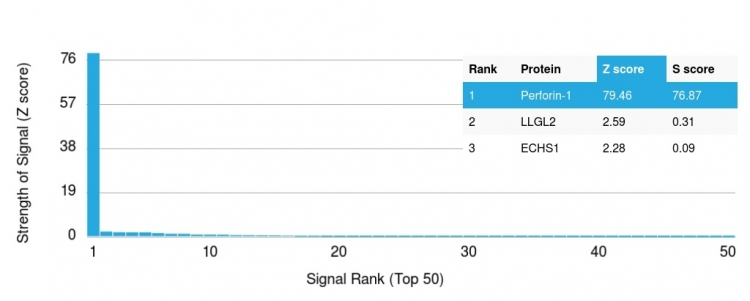
Analysis of Protein Array containing more than 19,000 full-length human proteins using Perforin-1 Mouse Monoclonal Antibody (PRF1/2468). Z- and S- Score: The Z-score represents the strength of a signal that a monoclonal antibody produces when binding to a particular protein on the HuProtTM array. Z-scores are described in units of standard deviations (SDs) above the mean value of all signals generated on that array. If targets on HuProtTM are arranged in descending order of the Z-score, the S-score is the difference (also in units of SDs) between the Z-score. S-score therefore represents the relative target specificity of a Monoclonal Antibody to its intended target. A Monoclonal Antibody is considered to specific to its intended target if the Monoclonal Antibody has an S-score of at least 2.5. For example, if a Monoclonal Antibody binds to protein X with a Z-score of 43 and to protein Y with a Z-score of 14, then the S-score for the binding of that Monoclonal Antibody to protein X is equal to 29.
Perforin antibody [PRF1/2468]
GTX17985
ApplicationsELISA, Other Application
Product group Antibodies
TargetPRF1
Overview
- SupplierGeneTex
- Product NamePerforin antibody [PRF1/2468]
- Delivery Days Customer9
- Application Supplier Note*Optimal dilutions/concentrations should be determined by the researcher.Not tested in other applications.
- ApplicationsELISA, Other Application
- CertificationResearch Use Only
- ClonalityMonoclonal
- Clone IDPRF1/2468
- Concentration0.2 mg/ml
- ConjugateUnconjugated
- Gene ID5551
- Target namePRF1
- Target descriptionperforin 1
- Target synonymsHPLH2, P1, PFP, perforin-1, cytolysin, lymphocyte pore-forming protein, perforin 1 (pore forming protein)
- HostMouse
- IsotypeIgG2b
- Protein IDP14222
- Protein NamePerforin-1
- Scientific DescriptionThis gene encodes a protein with structural similarities to complement component C9 that is important in immunity. This protein forms membrane pores that allow the release of granzymes and subsequent cytolysis of target cells. Whether pore formation occurs in the plasma membrane of target cells or in an endosomal membrane inside target cells is subject to debate. Mutations in this gene are associated with a variety of human disease including diabetes, multiple sclerosis, lymphomas, autoimmune lymphoproliferative syndrome (ALPS), aplastic anemia, and familial hemophagocytic lymphohistiocytosis type 2 (FHL2), a rare and lethal autosomal recessive disorder of early childhood. [provided by RefSeq, Aug 2017]
- Storage Instruction-20°C or -80°C,2°C to 8°C
- UNSPSC12352203




![IHC-P analysis of human follicular lymphoma using GTX01949 Perforin antibody [5B10]. Note focal granular staining of occasional cytotoxic T lymphocytes.](https://www.genetex.com/upload/website/prouct_img/normal/GTX01949/GTX01949_20200811_IHC-P_107_w_23053121_438.webp)